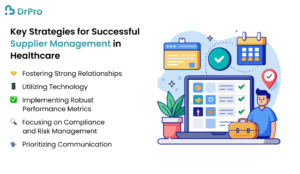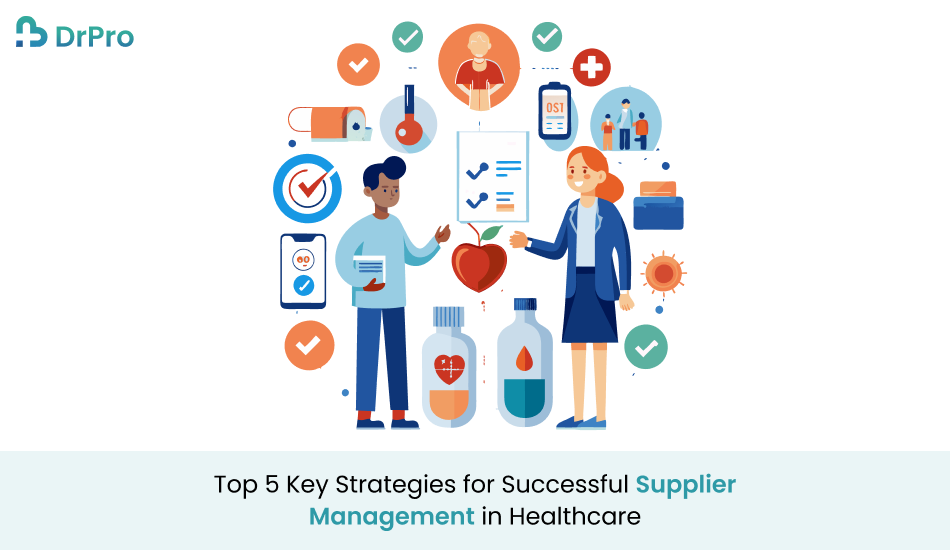Quick Summary
In the context of the healthcare industry specifically, supplier management is considered to be extremely important to be able to ensure the availability of the right quality products and services from the appropriate suppliers at the right time. This article discusses five key strategies that can enhance the Supplier Management system in healthcare: developing sound partnerships, leveraging technology, using high-performance measures, ensuring and embedding compliance and risk, and using communication actively.
Introduction
The supplier management department is one of the key elements that determine the effectiveness of the operation in healthcare facilities. In the context of rising demand for high, appropriate, and accessible quality healthcare and a proliferation of suppliers available to meet this need, healthcare organizations must address the issue of Supplier Management systems. Precise supplier management strategy integration will improve supplier partnerships, decrease overall expenses, and help to ensure that fundamental materials are delivered on time.
This article will discuss five main approaches to healthcare supplier management and provide effective measures that could be used to enhance cooperation with suppliers, decrease potential threats, and increase the yield of operations. Regardless of whether you are running a small clinic or a vast hospital network, you’ll be equipped with such tactics that will facilitate your organization sufficiently stocked and prepared to assist.
What is a Supplier Management System in Healthcare?
It can be defined as a structured way of ensuring that the suppliers that an organization uses give it value in terms of performance, while at the same time, delivering the least amount of risk. In health care, this entails working with several suppliers to gain the necessities such as medical equipment, drugs, and other essential products.
An effective Supplier Management system will enable healthcare organizations to have a steady supply of essentials to avoid interruption of the care they provide to patients. These steps include the identification of the potential supplier and the negotiation of the terms and conditions of the selling contract, supplier appraisal and assessing the performance of the supplier, and management of the buying-selling relationship.
Key Strategies for Successful Supplier Management in Healthcare

1. Fostering Strong Relationships
Suppliers are an important factor in the healthcare industry, and as such, the following points about the building and maintaining of healthy supplier relations are critical; The successful alliance of a buyer and a supplier relies on trust and thus the need to overcome supply chain hurdles.
Actions to Consider:
Regular Meetings:
Suppliers should have official or formal meetings established with the organization to address issues relating to the performance of the supply chain and or system, expectations in the processes of the supply chain, and or any emerging issue. Such interviews are essential in creating trust and conducting positive working relationships.
Partnership Approach:
Consider them as more than mere sources of supply. Have them participate in senior decision-making, and ask them what changes are admissible in the process or product.
Good working relationship translates to more appropriate pricing, fast service, and improved coordination in situations of crisis that are inevitable in a healthcare center.
2. Utilizing Technology
Supplier Management system is partially automated through the use by suppliers of certain forms of technology. The most important benefits that can be achieved from implementing the tools are higher efficiency, accuracy, and degrees of freedom throughout the supply chain.
Actions to Consider:
Inventory Management Systems (IMS):
Some of the uses of IMS include keeping track of stock, managing orders as well as supplier performance. A good IMS shall provide the actual rates so that several healthcare organizations can make the right decisions at the right time.
E-Procurement Solutions:
The degree of technology experienced here reduces the complexities of the purchasing process, enabling comparisons of suppliers, and contacts, and the management of contracts and communication. Consequently, through the adoption of e-procurement, some benefits accrue via cost savings as well as delivery of enhanced supplier relations.
The survey by the Healthcare Supply Chain Association reveals that 68 percent of healthcare organizations provided positive sentiments on the effects of technology solutions as a factor in the supply chain.
3. Implementing Robust Performance Metrics
It is therefore important to set key performance indicators before the evaluation of the performance of suppliers. Regarding the evaluation, metrics give a platform for comparison and the finding of gaps that need to be closed.
Actions to Consider:
Key Performance Indicators (KPIs):
Cherish the fact that it’s possible to set up unique KPIs appropriate for the particular nature of your organization. Some of the most typical indicators are on-time delivery frequency, quality control data, and order fulfillment.
Regular Reviews:
Provide supplier performance reports and compare them to set KPIs, at progressive intervals. This process enables organizations to know the suppliers who have not performed well and correct them.
Mandatory and effective key performance indicators not only promote compliance with established standards but also encourage vital supplier performance improvement.
4. Focusing on Compliance and Risk Management
Here, issues of compliance and clinical risk management are defining aspects of Supplier Management system in healthcare organizations. It is equally important for an organization to put efforts into ensuring that its suppliers meet the required standards.
Actions to Consider:
Supplier Audits:
Always perform frequent checkups on the suppliers to confirm standard legal requirements, for example, FDA rules and ISO standards. A verification enables the discovery of risk and determines whether suppliers conform to quality requirements.
Risk Assessment:
Assess supply risks to determine possible risks that could arise from supply examples being; the supplier’s financial position, supply chain breakdown, supplier country risks, etc. Having an early-prepared risk management strategy can reduce these risks to the happen.
According to research conducted in the Journal of Healthcare Management, organizations that effectively address issues of compliance and risk management can be up to 30% shy of facing supply chain disruption.
5. Prioritizing Communication
Communication plays a crucial role in managing suppliers. Information sharing and disclosure of information and this will assist in developing the right strategic understanding among stakeholders.
Actions to Consider:
Feedback Mechanisms:
Organise mechanisms of prompt feedback to ensure that suppliers provide feedback as well as qualify their grievances or ideas. This has the potential to improve interaction and communication between the two in terms of problem-solving.
Crisis Communication Plans:
The buyer should establish crisis communication strategies to anticipate disruptions in the supply chain. It also has the advantages of ensuring all stakeholders are on the same page in case of an incident and having a ready response style.
Supply chain communication as a major supply chain management practice is associated with an increase in the quality of supply chain responsiveness, specifically supplier communication, which in turn enhances the opportunity to correct problems in supplier relationships.
Conclusion
The management of supplier relationships in HC has been denoted to involve elements of relationship management, application of technology, performance metrics, compliance, and communication. Using these five strategies will help healthcare organizations improve their Supplier Management system and in the process support patient care and organizational improvement.
In the current environment, where almost every aspect of the healthcare sector is moving at the speed of light, the Supplier Management system is not only about how cheap it can be made; it is all about how patients can get the best care possible. By so doing, healthcare organizations will be in a position to design and implement a robust supplier management system to meet its and the patient’s needs.
ProjectTree and DrPro’s partnership brings a new level of synergy, combining advanced project management tools with innovative healthcare solutions.
FAQs
Q1. Why is a Supplier Management system important in healthcare?
Supplier Management system is one of the most important areas in healthcare because managing suppliers decreases the time for delivering vital products and services, which are imperative for patients. In general, management allows to save costs, increase the quality, and avoid many problems connected with the supply chain.
Q2. What are key performance indicators (KPIs) in the Supplier Management system?
Supplier Management system KPIs are thus defined as being measurable values that indicate a supplier’s performance. The most likely examples of KPIs are such mundane parameters as on‐time delivery, internal quality assurance, and order efficiency.
Q3. How can technology improve the Supplier Management system?
The procurement activities can be made easier through the use of technology, visibility is made possible in the supply chain to enable one to get information on what is required to make a certain decision. Inventory tracking and e-procurement are considered the key enablers that provide efficient tools.
Q4. What role does communication play in Supplier Management system?
Good relationships with the suppliers should be developed since communication is interesting for the improvement of effective communication. The key issues arise that the representatives of the organizations, therefore, the members of the collaboration, should openly communicate to discuss the problems, to share the goals, and to solve problems more effectively.
Q5. How can healthcare organizations assess Supplier Management system risks?
Supplier Management system risks can be evaluated in healthcare organizations if they conduct an audit, check their financial position, and take into consideration the possibilities of supply chain disruptions and non-compliance with legal requirements.


